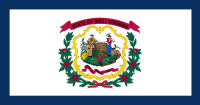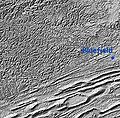Portal:West Virginia
The West Virginia PortalPanorama northwest, northeast and east from a ridge along West Virginia Route 42 between Elk Garden and Sulphur City in Mineral County, West Virginia (2016)
 West Virginia is a landlocked state in the Southern and Mid-Atlantic regions of the United States. It is bordered by Pennsylvania to the north and east, Maryland to the east and northeast, Virginia to the southeast, Kentucky to the southwest, and Ohio to the northwest. West Virginia is the 10th-smallest state by area and ranks as the 12th-least populous state, with a population of 1,793,716 residents. The capital and most populous city is Charleston with a population of 49,055. West Virginia was admitted to the Union on June 20, 1863, and was a key border state during the American Civil War. It was the only state to form by separating from a Confederate state, one of two states (along with Nevada) admitted to the Union during the Civil War, and the second state to separate from another state, after Maine separated from Massachusetts in 1820. Some of its residents held slaves, but most were yeoman farmers, and the delegates provided for the gradual abolition of slavery in the new state constitution. The state legislature abolished slavery in the state, and at the same time ratified the 13th Amendment abolishing slavery nationally on February 3, 1865. West Virginia's northern panhandle extends adjacent to Pennsylvania and Ohio to form a tristate area, with Wheeling, Weirton, and Morgantown just across the border from the Pittsburgh metropolitan area. Huntington in the southwest is close to Ohio and Kentucky, while Martinsburg and Harpers Ferry in the eastern panhandle region are considered part of the Washington metropolitan area, between Maryland and Virginia. West Virginia is often included in several U.S. geographical regions, including the Mid-Atlantic, the Upland South, and the Southeastern United States. It is the only state entirely within the area served by the Appalachian Regional Commission; the area is commonly defined as "Appalachia". (Full article...) Entries here consist of Good and Featured articles, which meet a core set of high editorial standards.
George Armitage Miller (February 3, 1920 – July 22, 2012) was an American psychologist who was one of the founders of cognitive psychology, and more broadly, of cognitive science. He also contributed to the birth of psycholinguistics. Miller wrote several books and directed the development of WordNet, an online word-linkage database usable by computer programs. He authored the paper, "The Magical Number Seven, Plus or Minus Two," in which he observed that many different experimental findings considered together reveal the presence of an average limit of seven for human short-term memory capacity. This paper is frequently cited by psychologists and in the wider culture. Miller won numerous awards, including the National Medal of Science. Miller began his career when the reigning theory in psychology was behaviorism, which eschewed the study of mental processes and focused on observable behavior. Rejecting this approach, Miller devised experimental techniques and mathematical methods to analyze mental processes, focusing particularly on speech and language. Working mostly at Harvard University, MIT and Princeton University, he went on to become one of the founders of psycholinguistics and was one of the key figures in founding the broader new field of cognitive science, c. 1978. He collaborated and co-authored work with other figures in cognitive science and psycholinguistics, such as Noam Chomsky. For moving psychology into the realm of mental processes and for aligning that move with information theory, computation theory, and linguistics, Miller is considered one of the great twentieth-century psychologists. A Review of General Psychology survey, published in 2002, ranked Miller as the 20th most cited psychologist of that era. (Full article...)Selected article -The Hatfield–McCoy Feud involved two American families of the West Virginia–Kentucky area along the Tug Fork of the Big Sandy River from 1863 to 1891. The Hatfields of West Virginia were led by William Anderson "Devil Anse" Hatfield, while the McCoys of Kentucky were under the leadership of Randolph "Ole Ran'l" McCoy. Those involved in the feud were descended from Joseph Hatfield and William McCoy (born c. 1750). The feud has entered the American folklore lexicon as a metonym for any bitterly feuding rival parties. The McCoy family lived primarily on the Kentucky side of the Tug Fork; the Hatfields lived mostly on the West Virginia side. The majority of the Hatfields, although living in Mingo County (then part of Logan County), fought for the Confederacy in the American Civil War; most McCoys also fought for the Confederates, with the exception of Asa Harmon McCoy, who fought for the Union. The first real violence in the feud was the death of Asa as he returned from the war, murdered by a group of Confederate Home Guards called the Logan Wildcats. Devil Anse Hatfield was a suspect at first, but was later confirmed to have been sick at home at the time of the murder. It was widely believed that his uncle, Jim Vance, a member of the Wildcats, committed the murder. (Full article...)General images -The following are images from various West Virginia-related articles on Wikipedia.
Did you know -
TopicsLargest citiesCategoriesNew articlesThis list was generated from these rules. Questions and feedback are always welcome! The search is being run daily with the most recent ~14 days of results. Note: Some articles may not be relevant to this project.
Rules | Match log | Results page (for watching) | Last updated: 2024-05-23 23:20 (UTC) Note: The list display can now be customized by each user. See List display personalization for details.
Related portalsWikiProjectsAssociated WikimediaThe following Wikimedia Foundation sister projects provide more on this subject:
Sources
|


















































